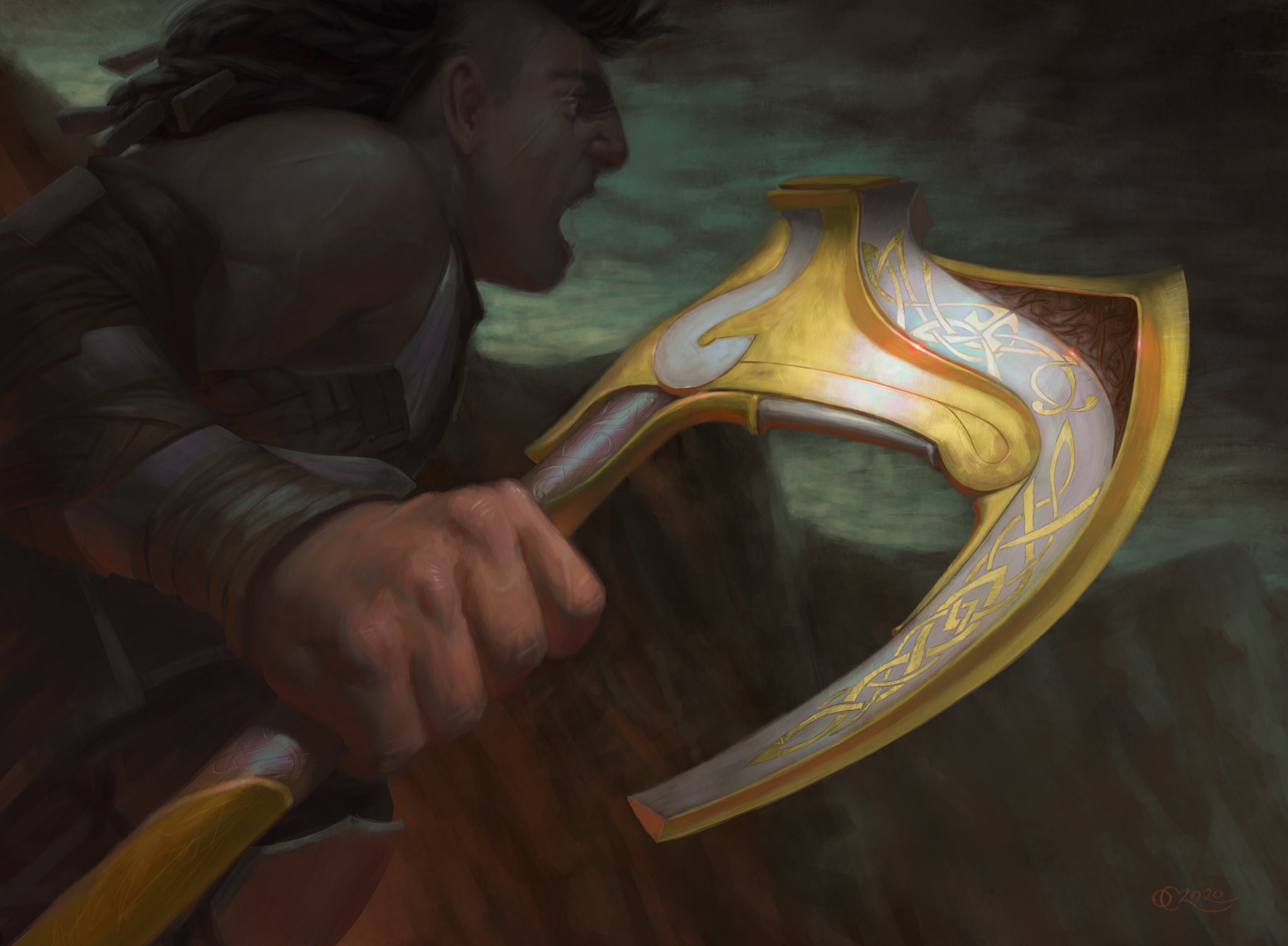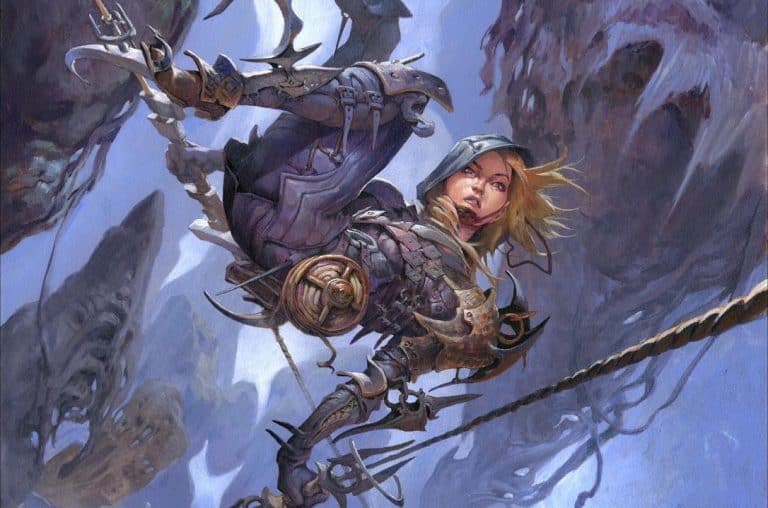Martial Weapons 5E: How Do They Work?
When choosing what kind of melee weapon you’re going to use in Dungeons & Dragons 5E, you’ve got quite a lot of choice. Simple weapons are, as you might expect, ones that don’t require a supreme amount of skill to use. These are the usual dagger, club, mace, things like that. Martial weapons on the other hand are a bit more complex. This weapon class holds more unique equipment and requires more skill to use. But if your character can master it, Martial weapons can do some serious damage. But there’s a lot to get through so let’s get right into this quick guide for Martial Weapons in D&D 5E.

Table of Contents
What is a Martial Weapon?

Martial Weapons are something that most classes aren’t able to use right off the bat. After all, they’re a weapon class that requires a lot of skill from its user. As such, only a Fighter, Paladin, or Ranger will grant you access to all Martial Weapons from the start. But you can always take a feat that allows you to use a Martial Weapon if you decide to pick a different class.
Proficiency in Martial Weapons allows you to use a wide range of unique weapons. And just like with Simple Weapons, you use them in conjunction with your proficiency bonus and Strength or Dexterity modifier. You may encounter a Finesse weapon when choosing from the Martial Weapon list, too, and these use a Dexterity modifier. This is exactly how a Scimitar works since it’s both a Martial and Finesse Weapon.
List of Martial Weapons
Here’s a list of all the Martial Weapons that can be found in the Player’s Handbook. There’s a huge amount of other weapons found in other expansions, but for now, we’ll stick with the basic list that can be found in a regular game of D&D 5E.
Martial Melee Weapons
This list is strictly for melee weapons found in this weapon class. Some also have a “Thrown” property, but most are strictly for use with opponents within close distance.
| Name | Cost | Damage | Weight | Properties |
| Battleaxe | 10 gp | 1d8 slashing | 4 lb. | Versatile (1d10) |
| Flail | 10 gp | 1d8 bludgeoning | 2 lb. | – |
| Glaive | 20 gp | 1d10 slashing | 6 lb. | Heavy, reach, two-handed |
| Greataxe | 30 gp | 1d12 slashing | 7 lb. | Heavy, two-handed |
| Greatsword | 50 gp | 2d6 slashing | 6 lb. | Heavy, two-handed |
| Halberd | 20 gp | 1d10 slashing | 6 lb. | Heavy, reach, two-handed |
| Lance | 10 gp | 1d12 piercing | 6 lb. | Reach, special |
| Longsword | 15 gp | 1d8 slashing | 3 lb. | Versatile (1d10) |
| Maul | 10 gp | 2d6 bludgeoning | 10 lb. | Heavy, two-handed |
| Morningstar | 15 gp | 1d8 piercing | 4 lb. | – |
| Pike | 5 gp | 1d10 piercing | 18 lb. | Heavy, reach, two-handed |
| Rapier | 25 gp | 1d8 piercing | 2 lb. | Finesse |
| Scimitar | 25 gp | 1d6 slashing | 3 lb. | Finesse, light |
| Shortsword | 10 gp | 1d6 piercing | 2 lb. | Finesse, light |
| Trident | 5 gp | 1d6 piercing | 4 lb. | Thrown (range 20/60), versatile (1d8) |
| War pick | 5 gp | 1d8 piercing | 2 lb. | – |
| Warhammer | 15 gp | 1d8 bludgeoning | 2 lb. | Versatile (1d10) |
| Whip | 2 gp | 1d4 slashing | 3 lb. | Finesse, reach |
Martial Ranged Weapons
Ranged weapons have similar properties to Melee weapons, with the obvious difference being that they’re primarily used for targets at a distance.
| Name | Cost | Damage | Weight | Properties |
| Blowgun | 10 gp | 1 piercing | 1 lb. | Ammunition (range 25/100), loading |
| Crossbow, hand | 75 gp | 1d6 piercing | 3 lb. | Ammunition (range 30/120), light, loading |
| Crossbow, heavy | 50 gp | 1d10 piercing | 18 lb. | Ammunition (range 100/400), heavy, loading, two-handed |
| Longbow | 50 gp | 1d8 piercing | 2 lb. | Ammunition (range 150/600), heavy, two-handed |
| Net | 1 gp | – | 3 lb. | Special, thrown (range 5/15) |
Martial Weapon FAQ
Just like Simple Weapons, Martial Weapons also have their own complexity. And even though they all fall under the same umbrella, there are quite a lot of different Martial Weapons that suit completely different characters. So let’s get some of the potential questions about these weapons out of the way.
What is the best D&D Martial Weapon?
The argument for which Martial Weapon is best in D&D 5E is going to come down to a player’s particular class and build. It’s not really a ‘one glove fits all’ type of situation. With that dais, there are some Martial Weapons that are likely to be especially useful.
Greatswords are undeniably fantastic Martial Weapons to choose. Not only are they huge and cover a lot of ground, they also straight up deal a lot of damage. 2d6 damage is nothing to scoff at and getting a good roll can potentially decimate an enemy. In that same vein, Greataxes are also very good and deal 1d12 slashing damage. And this is another avenue to dealing with enemies quickly.
Of course, Martial Weapons can also include ones with range. A Longbow is perfect for characters that want to stay away from the core of the fight and pick enemies off with 1d8 piercing damage. The Heavy Crossbow and Hand Crossbow are also both great choices here, too.
Characters that focus more on Dexterity do have some choices too. The Rapier, Scimitar, Shortsword, and Whip are all Finesse weapons and use your Dexterity modifier. Plus, we can’t forget about the ability to dual wield Shortswords. With the Dual Wielder Feat you can do some serious damage with the right kind of weapons.
Do Firearms count as Martial Weapons in 5E?
Simply put, Firearms do count as Martial Weapons in D&D 5E. Some DMs are a bit mixed on how to approach this, though. Since firearms can behave in a way that’s almost identical to crossbows, there isn’t much need to rebalance them. But whether they’ll be allowed and the way they work is really up to the DM. Some would be fine with it, others may want to add Firearm proficiency to make the use of them more of an important choice, and others may not want firearms at all. But if you’re game does include them, then they are considered to be Martial Weapons.
What classes have proficiency in Martial Weapons in 5E?
Only a handful of classes in D&D 5E have proficiency in Martial Weapons. Barbarians, Fighters, Paladins, and Rangers each start off with this proficiency. And this means that they can all make use of the full list of Martial Weapons. Since these classes are much more melee-focused than, say, a Sorcerer, they have a much larger pool of potential weapons to choose from. But this also means that these classes will have to choose their weapons carefully in order to correctly complement their build. Again, a Dexterity-focused character should use a Rapier, Scimitar, or Whip. And a ranged-focused character should choose a Longbow or Crossbow.
Can you use Martial Weapons if not proficient?
Yes you can still use a Martial Weapon if you aren’t proficient in it. However, you will not be able to gain any kind of proficiency bonus, which is pretty self-explanatory. And that’s basically the only downside. But it’s one that can seriously hamper your combat abilities. So yes, you can use martial weapons without proficiency, but it’s not necessarily the best decision.
If you’re neck deep into a campaign and decide you actually want to use a cool-looking Martial Weapon but lack proficiency, there’s good news. You don’t need to pick a Class with full Martial Weapon proficiency to be able to use Martial Weapons. Instead, you can take the Weapon Master Feat and gain proficiency in four weapons of your choice. You can choose either Simple or Martial Weapons, but you must choose four of them.
Conclusion for Martial Weapons in 5E
Martial Weapons are a step up from Simple Weapons in a few ways. Not only do some of them look really cool, but they also provide more specific utilities in combat. With the choice of ranged, finesse, and heavy weapons at your disposal, you’ve got a lot of potential weapons to use. But the key is knowing exactly what you want your character to be and how they fit into the wider group in combat. And once you’ve figured that out, the choice of which Martial Weapon to use should come easy. Hopefully, this guide helped you understand Martial Weapons a little more and gave you some ideas for how best to approach them.






